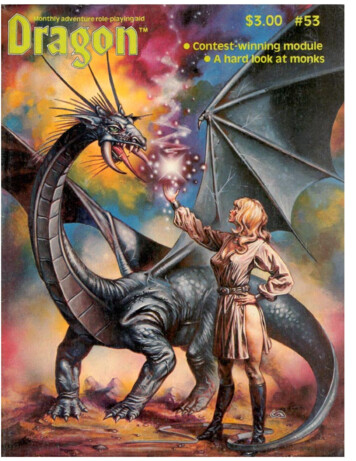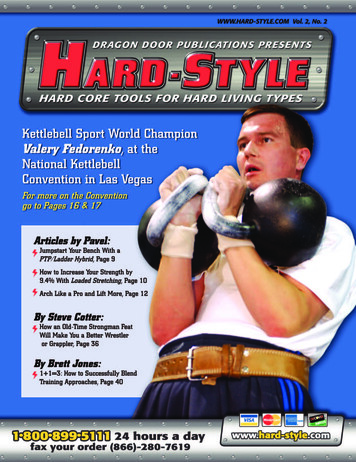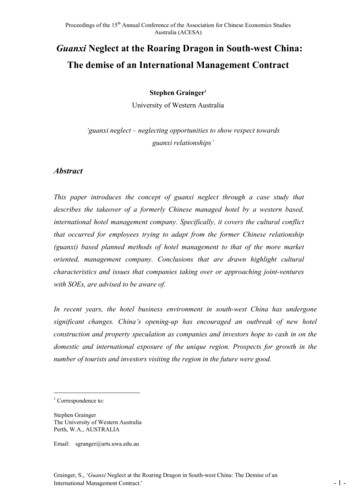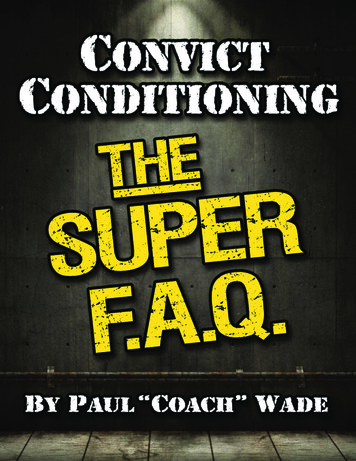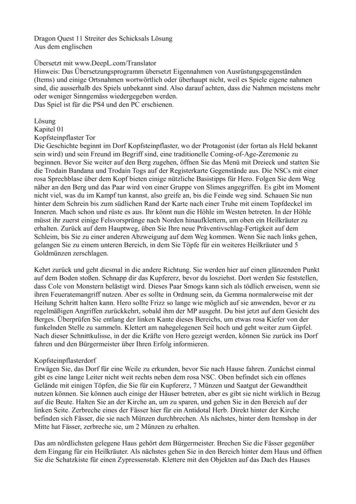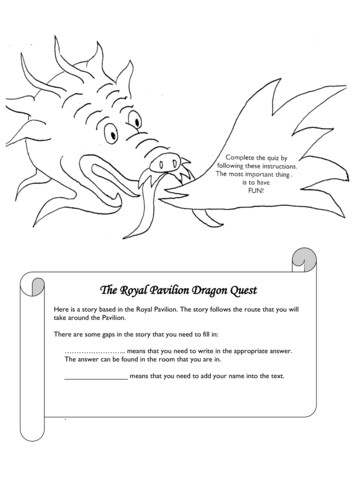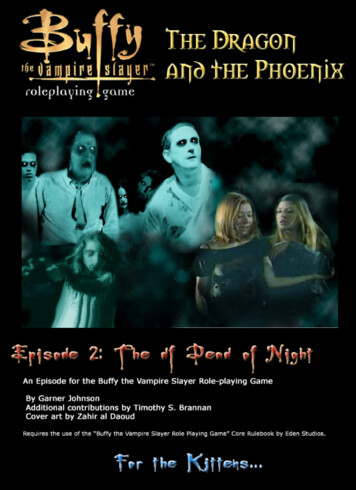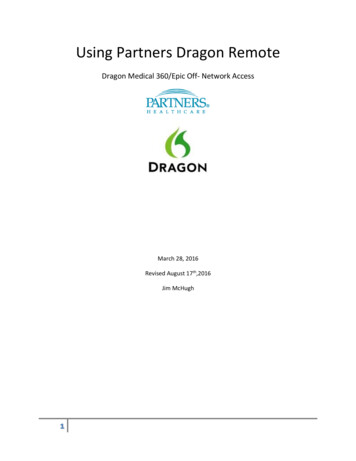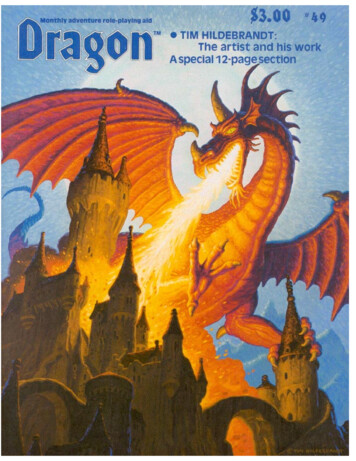
Transcription
May 19811
Vol. V, No. 11Vol. V, No. 11Welcome to issue #49 of DRAGONmagazine. Those of you who do notnormally read that tall skinny box to theright of this column should do so at thistime, as there have been some changesin the structure of the magazine staffsince last issue.It is difficult to not sound like I ambeating my own drum as I say that I amnow publisher, but such is the case. Iwould like to take this opportunity to express my thanks to E. Gary Gygax, President of TSR Hobbies, Inc., and theBoard of Directors for their confidencein me with this promotion. Also on thepromotion list is former Assistant EditorKim Mohan, who now becomes Editorin-Chief. In actuality, Kim has been performing all the functions normally assocrated with the title of editor for somemonths now, and it is only fitting that henow receive the title to go with the hassles. Congratulations, Kim! (Thank you,Jake. Same to you.).***As DRAGON magazine continues togrow (each issue is now read by morethan 150,000 people), we become moreable to bring you what we hope is thehighest quality gaming magazine on themarket. Part of the philosophy of DragonPublishing is to consider each publication as a whole, with respect to quality,from the paper to the printing to the writing itself to the artwork. Also, we try toprovide a publication that is both enjoyable and informative as whole.We hope we are fulfilling these philosophies this month with an effort of considerable expense and effort in presenting the work and words of Tim Hildebrandt. One of the true attractions of fantasy gaming is, indeed, the appeal ofquality fantasy artwork. Much of fantasygaming has been inspired by fantasy literature, classic heroic tales, and the accompanying illustrations. “A picture isworth a thousand words” has never beenmore true than when applied to fantasyart. Players of any fantasy adventuregame should be able to draw up an incredible scenario from this month’s cover.**exists: Fantasy Newsletter. Publishedmonthly by Paul and Susan Allen, P.O.Box 170A, Rochester, N.Y. 14601, thismagazine is a must for anyone wishingto keep up on the plethora of fantasy andscience fiction titles on the market today. In addition to reviews of everythingnew, Fantasy Newsletter contains regular columns by Karl Edward Wagner,Fritz Leiber, Mike Ashley, and BillWarren, interviews with noted authors,outstanding artwork and drawings, anda host of other regular and semi-regularfeatures of interest to readers. It is available for 15/year second class mail or 22/year first class to the U.S. andCanada.***I may have been somewhat overoptimistic in last month’s Rumbles when I announced the release of the upcomingBest of the Dragon, Vol. II as sometime inthe first of May. We’re working on it(material has been selected — it’ll be almost exclusively D&D /AD&D gameoriented), but it may take a little whilelonger to physically produce than anticipated — we’ve only got 18 hands, youknow. We’re looking at the last of May orfirst of June now.***Hidden in last month’s April issue inthe “Dragon Mumbles” column of theApril Fool section was our April FoolContest. First to respond to our instructions to drop us a post card (other thanthe mysterious anonymous phone callerwho said “consider a card dropped” andhung up) was John Sheley, Jr. of TerreHaute, Ind. John’s card states: “Yourbackwards paragraph in TD 48½ waswell hidden, but almost immediately apparent to my eagle eye and quick wit.Since all of my friends tell me I am a greatbig fool, I feel I am eminently qualifiedfor the April Fool Award.” Congratulations, John. You’re the fool.May 1981Publisher . . . . . . . . . . . Jake JaquetEditor-in-Chief . . . . . . Kim MohanEditorial staff . . . . . . . Bryce KnorrMarilyn MaysSales & Circ . . . . Debbie ChiusanoCorey KoebernickOffice staff . . . . . . . Cherie KnullJean LonzeRoger RauppContributing editors . . . Roger MooreEd GreenwoodThis issue’s contributing artists:Tim Hildebrandt Jeff DeeJeff LannersKenneth RahmanRoger RauppDave TrampierBrad ParkerJ. D. WebsterDRAGON magazine is published monthly byDragon Publishing, a division of TSR Hobbies,Inc. The mailing address of Dragon Publishingis P.O. Box 110, Lake Geneva WI 53147: telephone (414) 248-8044.DRAGON magazine is available at hundredsof hobby stores and bookstores throughout theUnited States and Canada, and through a limited number of overseas outlets. The magazinecan be purchased directly from Dragon Publishing by subscription. Rates are as follows, with allpayments to be made in advance: 24 for 12issues sent to a U.S. or Canadian address; 50U.S. for 12 issues sent via surface mail or 95 for12 issues sent via air mail to any other country.A limited quantity of certain back issues ofDRAGON magazine can be purchased directlyfrom the publisher by sending the cover priceplus 1 postage and handling for each issueordered. Payment must accompany all orders.The issue of expiration for each subscriptionis printed on the mailing label for each subscriber’s copy of the magazine. Changes of address for the delivery of subscriptions must bereceived at least 30 days prior to the effectivedate of the change in order to insure uninterrupted deliveryAll material published in DRAGON magazinebecomes the exclusive property of the publisherupon publication, unless special arrangementsto the contrary are made prior to publication.DRAGON magazine welcomes unsolicited submissions of written material and artwork; however, no responsibility for such submissions canbe assumed by the publisher in any event. Anysubmission which is accompanied by a selfaddressed, stamped envelope of sufficient sizewill be returned to the contributor if it cannot bepublished.DRAGON is a trademark for Dragon Publishing’s monthly adventure playing aid. All rightson the contents of this publication are reserved,and nothing may be reproduced from it in wholeor in part without prior permission in writingfrom the publisher. Copyright 1981 by TSRHobbies, Inc. USPS 318-790. ISSN 0279-6848.Second class postage paid at Lake Geneva,Wis., and at additional mailing offices.*Speaking of fantasy literature, I’ve gotto get in a quick plug for an exceptionallyfine publication you may not be aware2
May 1981you’re used to finding inside DRAGON magazine? Not hardly.For starters, we’ve finally taken steps to satisfy all you honorablereaders who’ve been asking for information on the Samurainon-player character. An updated and lengthened version of thecharacter class, which made its debut in the pages of DRAGONmagazine nearly five years ago, should make you very happy.For those of you who prefer a more detailed version of theAlchemist NPC, Len Lakofka offers just such a character inLeomund’s Tiny Hut.Also inside are many other special articles to help embellishan adventure or an entire campaign, including: Karl Horak’sdescription of how to construct a three-dimensional world onpaper, complete with a pattern you can use to build a 20-sided“sphere” with a hex-grid pattern already printed on its surface;lists of names, provided by author Glenn Rahman, which can beused to christen characters in a historically accurate fashion;Jon Mattson’s system for converting AD&D monsters into creatures compatible with a Chivalry & Sorcery game; Paul Crabaugh’s suggestions for expanding the scope of the DragonQuest rules, and Gary Snyder’s guidelines for how to use theWish and Limited Wish spells — both as a “giver” and a “getter.”Following that article is a bit of “wishful writing” on the part ofcontributing editor Roger Moore which we hope you’ll enjoy aswell. Roger is also the responsible party for this issue’s edition ofGiants in the Earth.Our other contributing editor, Ed Greenwood, is representedby an essay in Up on a Soapbox, describing how a DM canindoctrinate new players to a role-playing game without tellingthem any more than they absolutely need to know.Administrators and agents involved in a TOP SECRET mission can now choose from a wider assortment of ammunitionthan offered in the official rule book, thanks to the latest installment of The Rasmussen Files. Other regular columns we couldpack into these pages include Simulation Corner, where JohnPrados examines the issue of being a free-lance game designer;another bit of background for DIVINE RIGHT players by gamedesigner Glenn Rahman in Minarian Legends; another SquadLeader scenario from Bryan Beecher; a pair of new dungeonadventure timekeeping computer programs in The Electric Eyeby Mark Herro; and another two pages of miniature-figure reviews by Bill Fawcett in Figuratively Speaking.All in all, you have 120 pages of reading in store for you . . . andonly a month until we’ll do it all over again. — KMelcome to issue #49 of DRAGON magazine,the most conventional and unconventionalcollection of articles and artwork we’ve everput between two covers. And just what doesthat mean? Read on, and it will all be clear injust a little while.The unconventional part is this issue’s special inclusion,which doesn’t have anything directly to do with playing a gamebut has everything to do with the world of fantasy. The offeringis titled “A Hildebrandt Brother” and is the result of interviewsand photo sessions conducted by staff member Bryce Knorr atthe home of Tim Hildebrandt, who, as they say on the talkshows, needs no introduction. For an insight into Tim the person, read the interview. For some sights of the paintings whichhave taken him to the pinnacle of professional success, checkout this month’s cover — done especially for DRAGON magazine — and the selection of other paintings reproduced alongwith the interview. We are very, very proud of these pages, andwe hope it shows.To find the conventional part of #49, turn two pages after thisone to the start of a special feature section on the related subjects of tournaments and conventions. The nine pages of text inthis section include Allen Barwick’s plea for fairness and consistency in the judging of role-playing tournaments; Philip Meyers’unfavorable assessment of the structure of last year’s AD&D Open Tournament, accompanied by a response from FrankMentzer of TSR Hobbies; preview stories on the Gen Con Eastand Gen Con XIV Conventions; information about two otherspecial events of interest to gamers; plus the most extensivelisting of upcoming conventions that we could assemble beforegoing to press. Elsewhere in the magazine you’ll find preregistration brochures for Gen Con East and Gen Con XIV — atotal of 22 more pages of very conventional stuff.Does that mean there wasn’t room for all the “regular” thingsSPECIAL ATTRACTIONA Hildebrandt Brother — Tim talks about his art, his life,and the creation of fantasy . . . . . . . . . . . . . . . . . . . . . . . . . . 41REGULAR OFFERINGSOut on a Limb — Letters from readers . . . . . . . . . . . . . . . . . . . . .The Rasmussen Files — TOP SECRET ammunition . . . . . .Giants in the Earth — Holger Carlsen . . . . . . . . . . . . . . . . . . .Hugi . . . . . . . . . . . . . . . . . . . . . . . . . . . . . . . . . . . . . . . . . . . . . . .Ellide . . . . . . . . . . . . . . . . . . . . . . . . . . . . . . . . . . . . . . . . . . . . . .Dragon’s BestiaryNogra . . . . . . . . . . . . . . . . . . . . . . . . . . . . . . . . . . . . . . . . . . . . . .Leomund’s Tiny Hut — The Alchemist NPC . . . . . . . . . . . . . . .Simulation Corner — To free-lance or not? . . . . . . . . . . . . . . .Squad Leader scenario — The fall of Budapest . . . . . . . . . . .Minarian Legends — The Eaters of Wisdom . . . . . . . . . . . . . . .The Electric Eye — More timekeeping programs . . . . . . . . . .Up on a Soapbox — Keeping players in the dark . . . . . . . . . .Figuratively Speaking — Miniatures in review . . . . . . . . . . . . .Dragon’s AuguryThe Hammer of Thor . . . . . . . . . . . . . . . . . . . . . . . . . . . . . . . .Assault on Leningrad . . . . . . . . . . . . . . . . . . . . . . . . . . . . . . .World Campaigns . . . . . . . . . . . . . . . . . . . . . . . . . . . . . . . . . . .Wohrom . . . . . . . . . . . . . . . . . . . . . . . . . . . . . . . . . . . . . . . . . . .Dragon Mirth — Cartoons to campaign by . . . . . . . . . . . . . . . .Wormy . . . . . . . . . . . . . . . . . . . . . . . . . . . . . . . . . . . . . . . . . . . . . . . . .Finieous Fingers . . . . . . . . . . . . . . . . . . . . . . . . . . . . . . . . . . . . . . . .OTHER FEATURESTournament/convention section:In the interest of fairness. — Judgements on judges . . . 6The Slave Pits revisited — AD&D Open suggestions . . 8Mentzer’s reply: It isn’t that easy . . . . . . . . . . . . . . . . . . 9Conventions galore — A big schedule . . . . . . . . . . . . . . . 12Game Con attendees hear their heroes . . . . . . . . . . . . . . . 14Gen Con keeps on growing . . . . . . . . . . . . . . . . . . . . . . . . . . 15Gen Con East fills Origins “hole” . . . . . . . . . . . . . . . . . . . . 15Painting contest has nine ways to win . . . . . . . . . . . . . . . . 16Game design made . . . easy? . . . . . . . . . . . . . . . . . . . . . . . . 16Samurai: An honorable NPC . . . . . . . . . . . . . . . . . . . . . . . . . . . . . 18Getting a world into shape — Polyhedrals with paper . . . . . . 28Historical names make for better games . . . . . . . . . . . . . . . . . . 32Monster mixing: AD&D creatures adapted for C&S . . . . . . . . 34Best wishes — Principles for proper wishing . . . . . . . . . . . . . 62Wishing makes it so — Fiction . . . . . . . . . . . . . . . . . . . . . . . . . . . 65Travel & threads for DragonQuest . . . . . . . . . . . . . . . . . . . . . . . 68What’s New? — This comic strip, for one thing . . . . . . . . . . . 903422303031545669707276798284858586889192
Vol. V, No. 11‘A few complaints’Dear Editor:I’ve been involved in the D&D game forabout a year now, and it always bugged methat there was no provision for archers in thecombat system or the character classes. Soyou can imagine my enthusiasm when I sawthe Leomund’s Tiny Hut article in #45. However, I have a few complaints about parts ofthat article which I wish to air, in the order oftheir appearance in the article.First — “Magic-Users must learn to throw adagger. First to fifth-level M-Us are -5 to hitwith a dagger, whether they like it or not,whenever they try to throw it.” Not only do Inot like this, but I will not accept it. If a persondecides to become a Magic-User, he will beaware, or informed, of his/her limitations as toweaponry. An MU will, therefore, learn tothrow a dagger, darts, use a staff, all whilelearning to be a MU. The only excuse for sucha subtraction is poor Dexterity, 11 or less forexample, and then it should be a subtractionof one for each point below that minimumlevel.Second — “Kobolds, goblins, dwarves,gnomes and halflings cannot become archers.” In the last chapter of the third book of theLord of the Rings trilogy, there are no lessthan three incidents where the effectivenessof hobbit archers is demonstrated. Also, referto the AD&D Monster Manual, p. 50, underhalflings, under special attacks, note “ 3 withbow or sling.”Third — “It is very rare for an archer to use ashort bow or any type of crossbow. Archersgain no bonuses to hit or damage from thoselatter missile weapons.” According to my information, the crossbow was invented BEFORE the longbow! It was a portable arbalest(a siege weapon used to hurl stones or spearsover castle walls). The Chinese invented a5-shot repeating version of the crossbow, tothe detriment of the Huns. A crossbow is asaccurate as a rifle at distances of up to 500yards, and more effective than a rifle at thatdistance, due to the blades on the head (of thebolt). Crossbows were used to smash throughthe armor used at the time. Only the thickestof shields could deflect a bolt, and no bodyarmor could stop a direct hit.An archer could be trained to use a crossbow in far less time than a longbow, but once(one was) learned it was all but impossible tolearn the other. An archer should specifywhich bow he is using, and receive a subtraction on his “to hit” number if he tries to use theother. If the crossbow is specified, state whatkind it is. Some could be cocked by hand;these will have a range equal to that of thebest longbow, a touch more accuracy, andhalf the rate of fire as for a crossbow thatcannot be cocked by hand. Others werecocked by a windlass (a rope-and-pulley arrangement). These can reach out to 500 yardswith good accuracy, but you’ll only get oneshot off every three rounds. At close range,such a weapon is useless.As for the statement made about the shortbow, refer to my statement concerning hobbits (what else would they use?).The balance of the article was interestingand informative. I have already earmarkedone of my future characters as an archer.(Please note that all of my rebuttal refers tonormal weapons used by persons with normalstrength. Obviously an archer with 18/00Strength could get off one shot per roundeven with the most powerful of crossbows,because he could cock it by hand.)William G. WelshDetroit, Mich.This is by no means the first letter of thisgeneral type that we have received, and itsurely won’t be the last. Generally, our response to William’s arguments is the same ason other previous occasions when we’ve dealtwith a “Here’s what’s wrong with this article”letter: First and foremost, we do NOT dealwith the “facts” of the situation — for instance, whether or not William’s descriptionsof the crossbow are factual and historicallyaccurate. This is not the place to stage a confrontation over crossbows, because the “rightness” or “wrongness” of information like thisis secondary to the main issue, which is this:None of the ideas presented in articles inDRAGON magazine are official rule changesor additions, unless the article specificallysays so (and there haven’t been very many ofthose). The people who write articles that wepublish aren’t trying to get everyone to playthe way they do, and we certainly don’t holdthat opinion ourselves. As is the case withmany of the game rules themselves, the articles in DRAGON magazine are suggestions,ideas and alternatives. Any DM or player whocan make use of part of the information in anarticle but wants to delete or alter other thingsin the same article is entirely free to do so.Whether a particular rule or an entire campaign is “authentic,” playable, or even desirable is a decision that can only be made by themembers of the playing group or the DM, notby what we decide to publish in the pages ofDRAGON magazine.In the case of a Leomund’s Tiny Hut article,4the above statements apply to a greater degree than for other types of articles. The ideasexpressed in Len Lakofka’s column are entirely his own, and are almost all, if not all, basedon the campaigns which he has conductedover the past several years. The way Len Lakofka does something is not necessarily theway William Welsh, or anyone else, has to doit. Len takes special pains to point this out inthe text of his columns, emphasizing in oneform or another the fact that his columns areunofficial, and any reader, player or DM is freeto alter or eliminate any sections of an articlewhich do not suit him or her.One minor point that has been made beforebut bears repeating has to do with William’ssecond objection. Regardless of how anyonefeels about whether halflings can be archersor not, it is a fact that no direct connection isintended or should be inferred between thehalfling character as depicted in the D&D andAD&D rules and the hobbit character as portrayed in Tolkien’s books. It is no secret thatthe halfling race is, at least in superficial ways,modeled rather closely after the hobbit. Butthis alone is not enough to draw a firm parallelbetween the two character types. The rulesfor the D&D and AD&D game systems drewsome of their inspiration from the Ring trilogy, as well as from dozens of other works offantasy and historical literature. Again, anyparticular DM or group of players can chooseto develop a campaign which is as faithful toTolkien’s world as they can make it. However,it is inappropriate to demand or suggest thatthe rules for AD&D be “bent” to accommodate this world view. Any group which playsAD&D strictly by the books will not be able tostage a Tolkien-type campaign. Any groupwhich chooses to change some of the officialrules is free to do so, as long as the changesare agreeable to those in the group. Butchanged rules aren’t rules, and Middle Earthis not a D&D universe. — KMPlea to paintersDear Editor:I am in the process of writing a bookdevoted to the painting of miniature figuresfor fantasy, adventure and military games. Thisdetailed, step-by-step instruction manual willcover all of the techniques and materials usedin painting miniature figures. Hopefully, it willbenefit both the novice and master miniaturepainter, in addition to broadening the interest(Turn to page 86)
May 19815
Vol. V, No. 11In the interestof fairness.by Dr. Allen BarwickPersonally burnedThree weeks before this article waswritten, at the end of the final round of atournament at Origins, the DM announced that the winner was a player who hadnot said a word during the tournament.The DM explained that this person wasthe best role player. Unbeknownst to therest of us, the winner had been writingthe DM notes to explain his actions;those actions were — NONE! Was theDM’s decision a quality judgment?ObjectivesThis article strives: 1. to give examplesof good and bad judging in fantasy roleplaying tournaments, 2. to explain whybad judging can occur, 3. to offer someguidelines for judging, and 4. to explainhow to use these guidelines.ExamplesAt Origins ’80, Katy Partridge’s thiefdied (-1 hit points) while only 30 minutesinto Castle Morncrest. We got her bodyback to life by binding her wounds andby using a Cure Light Wounds spell.Katy went on to do an excellent roleplaying job and to play with exceptionalintelligence. The DM, George Johnson,justly awarded her the first place for ourgroup. Katy was later awarded secondplace in the overall standings of all thegroups.In many other tournaments, dying in atournament round is like a knockdown inboxing — the player loses the round. Inelimination round events, the player isusually out of the tournament once thecharacter is killed.Sharon Midgett related the tragic tournament story of how she told the lostcaller what to do, the incompetent Magewhat spells to throw, and the confusedCleric what to do to heal others. At thesame time, Sharon fought bravely, foundseveral traps the party could avoid, andsuggested the best weapons for thegroup to use against exotic monsters.Yet when the time came to select thewinner, she was passed over for a silent,“dumb-blonde type” woman.Penny Petticord, at the Spring ’80 W.Va. U-Con II, happily chose as the bestplayer in her tournament an elf who hadsolved more puzzles than all the othermembers of the group put together, yetwho sacrificed himself in the final roundagainst the foe called “Death,” so thatthe rest of his party might survive.Tim (Ollie) Cahoon at GenCon XII selected as the best player a Mage whoalways had the knack for coming up withthe right spell at the right time. Unfortunately, this same Mage didn’t even knowwhat a Magic Missile was and had beencoached all through the tournament bythe minor Mage. Ollie was honestenough, though, that when he heard thetruth in a debriefing with the players laterthat evening, he changed his mind andinvited the secondary Mage to the finalround also.Enough! We’ve all seen the best playerpassed over, but we’ve never questioned“god’s” judgment. Thus, the unfair acthas stood. Only through an extraordinary DM are the ablest players sometimes recognized.How bad judging occursWhy does such bad judging occur?The reasons are many. Often the DM hasno standards by which he can determinethe best player. At other times the standards are too vague: “Choose the bestplayer.” Occasionally the standards aretoo arbitrary: “The one with the most hitpoints at the end.” Well, if nobody in theparty takes damage, then a certain Fighter who starts out with the most hit pointswill win.Fantasy role-playing was meant to befun, and playing in a tournament can bethe height of that fun. Enjoyment is possible without winning, but watching themost qualified person be continuallypassed over and the “boob” get firstprize is a real damper. However, if thegroup does not know the rules by whichthey are being judged, they cannot playthe “judging” game. How often does thissituation of rule-ignorance occur? Unfortunately, even in the third AD&D Masters Tournament one of the rules for6winning was kept secret from the players. Still, this is but one rule, and not allthe rules, as sometimes happens.Judging GuidelinesWhat would help a DM, then, to determine the winner?First, the question must be answered:What is meant by the winner — the bestteam or the best player?If several rounds are to be played andthe best teams move on to the nextround, then the best teams are determined by a lot of advance work amongall the DM’s. The DM’s have to agreebeforehand on how many points theteam receives for doing each of thefollowing:1. Achieve the final objective or comeclosest to it.2. Accomplish as many of the minorobjectives as possible.3. Role play their characters.4. Take the least damage.5. Have the fewest team members die.6. Use up as little as possible their nonrechargeable magical weapons.7. Make the best map.8. Accomplish the objective(s) in asshort a time as possible.9. Disrupt the enemies’ way of life asmuch as possible.10. Think before fight.11. Fight before desert.12. Make personal sacrifices so thatthe team may go on.13. Sidetracked as little as possible.14. Cooperate mutually before argue.15. Take initiative before indecisiveness.16. Find artifacts and magical itemsand identify them as to their proper use.17. Collect treasure.18. Act wise before stupid or rash.19. Rescue any prisoners of a similaralignment.20. Solve puzzles.21. Quash rumors and establish facts.22. Gather intelligence and interrogate.23. Use native and special inherentabilities.24. Prudently select equipment, spells,and weapons to take with them on themission.
May 198125. Use magical and clerical spells, asopposed to hoarding the spells whentheir use would have helped.26. Be honest, as opposed to cheatingon such things as die rolls, current hitpoints, spells used up, position of character relative to environment, using onlyknowledge available to that character,and following the rules set down at thebeginning.27. Bypass traps.28. Kill monsters.29. Enlist aid: convert possible monsters.30. Were undetected by monsters.31. Avert fighting via reasoning.32. Check rooms.33. Avoid disaster.34. Are not captured.35. Act before being passive.36. Do not argue with the DM.The best player is determined by useof most of the above list (properly modified), plus the following:1. Works in harmony with the group.2. Provides good suggestions.3. Organizes.4. Follows and leads.5. Lets others in the party contribute.6. Accomplishes individual goals.7. Uses good combat strategy.8. Is polite to the other players and tothe DM.How to use the guidelinesNot all the above guidelines need beused, but if a copy could be made available to all the DM’s and the players of thejudging guidelines and special “house”rules that are being used, play would beimmensely enhanced.Complicated numerical formulas arenot desirable due to the short time spanin which a tournament is over and players have to rush to another tournament.If prerolled characters are used, thecharacters should be numbered, and theplayers required to sit in a semicircle innumerical order in the seat determinedby the number of their character. TheDM should pass a piece of paper aroundfor a seating chart, and have everyoneprint their name beside the number oftheir character. This sheet can be prepared beforehand and have on it, at asingle glance, such useful items as eachcharacter’s occupation, hit points, andspells.Prerolled characters in tournamentplay are highly desirable, because theycan be pretty well filled out beforehandby the DM, thus saving a lot of planningand preparation time by the players.Having the players put up one of theirown characters as a “hostage” in exchange for the prerolled character makesthe players pay a little more attention tothe game. A typical penalty for bad playwould be no experience gained or deathto their own character (followed by automatic resurrection with a corresponding drop in constitution.) A good rewardmight be anything from a tenth of a levelin experience points to moving up awhole level.The DM should have the players makeoccasional “saving throws;” observe thethrows, but ignore the results. This tacticwill keep the players more awake. Also,occasionally asking the players wheretheir characters are (the use of miniatures helps) keeps them alert.Each player should speak for him orherself when performing a function, i.e.,the Fighter should not tell the Thief thecorrect procedure to use to check fortraps. How can a Fighter know the details of another’s life study? Such out-ofrole suggestions should be penalizedeach time, and the player should bemade aware of the penalty on the firstoffense. For each good suggestion thatproperly falls within the realm of eachplayer’s environment and expertise, theplayer should get a plus. For each patently foolish suggestion or stupid action,the player should get a minus. For eachintelligent action, the player should get aplus. These points can be recorded silently on the seating chart from behindthe judge’s screen.if there are 12 people in a party andonly one of them kills a monster, then heshould get 12 “plusses” minus one, or 11points. If 7 people in the party swing onthe monster (whether or not they actually hit it) and the monster eventually dies,then they each get 12 minus 7, or 5points. If 11 help kill the monster, theneach of those 11 would receive 1 tournament point. In this latter case, if th
Alchemist NPC, Len Lakofka offers just such a character in Leomund’s Tiny Hut. Also inside are many other special articles to help embellish an adventure or an entire campaign, including: Karl Horak’s description of how to construct a three-dimensional world on paper
